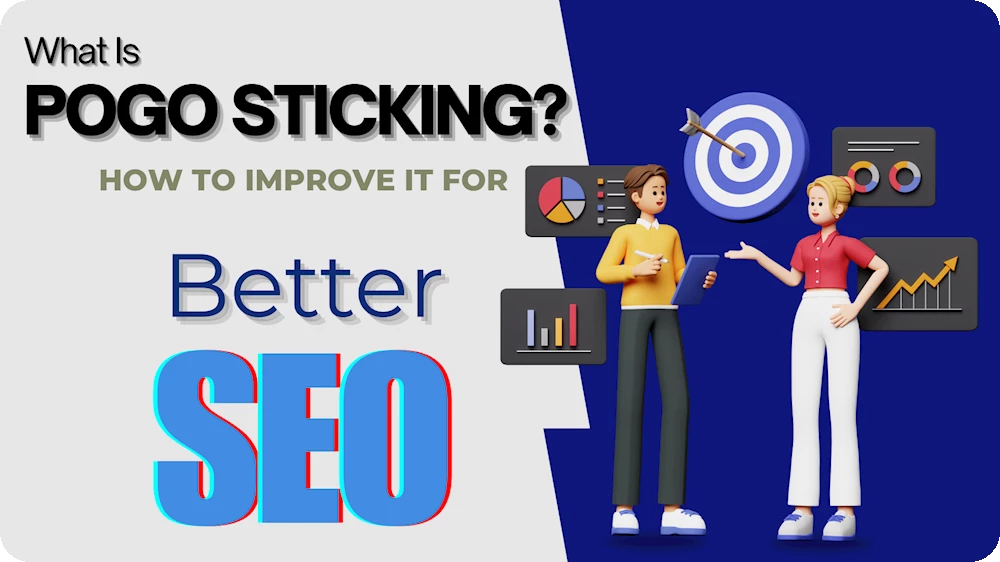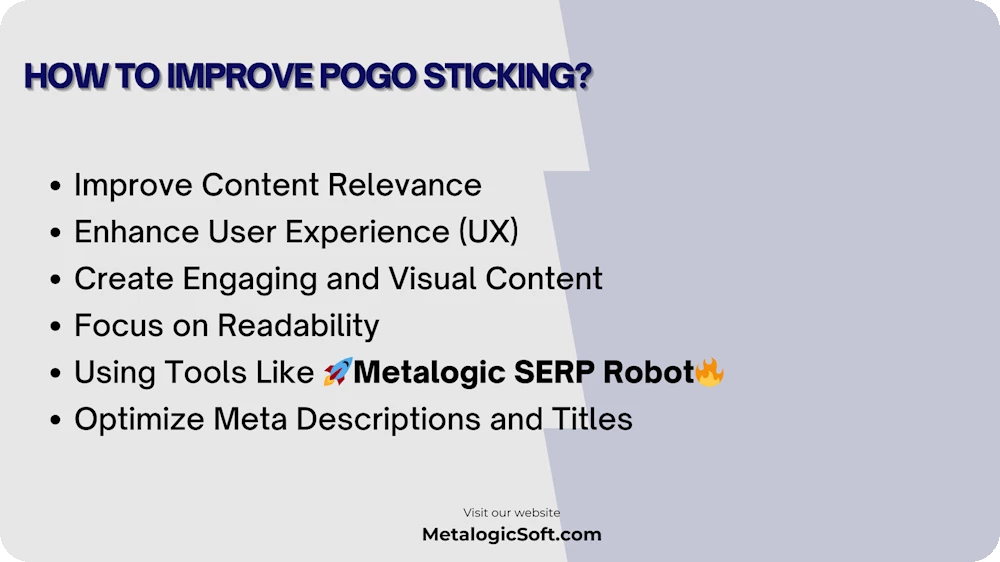
The term is often used in the area of search engine optimization to point out a user behavior that can leave a negative effect on your website’s rank. When a user clicks on a search result and returns to the previous page with little to no dwell time and clicks on another result, the search engine interprets that as the first result being irrelevant and unsatisfactory. This user behavior tells the search engine it made a mistake in suggesting that website and even though the site contained the inserted keyword, it may not be the right suggestion. This fast back and forth movement of the user between the result page and given results, is called “pogo sticking” which can be harmful for your website’s SEO if ignored.
Pogo Sticking can be monitored and controlled. SEO experts will always keep pogo sticking in check in order to minimize any probable unwanted effect. Further in this article you will find a clearer outline to what pogo sticking really is and why it is critical to identify and resolve specific pogo sticking cases in real situations.
Causes of Pogo Sticking
Google and engines alike, put user experience before anything. Their algorithms are specialized in evaluating factors such as pogo sticking in order to categorize and treat websites accordingly. Repeated instances of such factors will leave a negative effect on SEO. The following are the leading causes of pogo sticking:
- User Dissatisfaction: This may be the main reason for a user to quit immediately. The content may be irrelevant or ineffective. Since engines try to deliver the best experience, high pogo stick rate will label the content worthless and affect organic traffic negatively.
- Disorganized Content: User often leave if the page doesn’t provide the answer to their search query up front. Keeping the content structured and concise while avoiding irrelevance will resolve this issue.
- Outdated Content: Regular updates and removal of outdated sections will ensure accuracy and relevance. Fresh contents attract more organic traffic and keep users engaged for longer durations.
Effects of Pogo Sticking
The immediate return of the user to the search results page after having clicked on a result, called pogo sticking, may not even be because of inauthentic content but in fact user’s own mistake. However, the action is understood as that particular site having failed in providing users with what they need.
This phenomenon is not to be confused with bounce rate, a completely different concept in SEO. While a bounce is to visit a site and to leave without any extra interactions, pogo sticking is to leave a site instantly after having clicked through, directly implying user dissatisfaction.
Search engines such as Google closely monitor user behavior, which means websites that have caused multiple occurrences of pogo sticking for a certain keyword will be labeled as irrelevant or incompetent in providing useful information. This will lower the SERP ranking over time, affecting organic traffic to your website and hindering SEO.
Few outcomes of high pogo sticking rate are:
- Lower Engagement Metrics: Pogo sticking can distort important statistics and metrics of page views per session and dwell time (both indicators of performance).
- Reduced Trust: high pogo sticking rate will decrease engine’s trust in your website and label the site unhelpful. This will show itself through decreased rank and site visibility for real users.
Preventing Pogo Sticking
Improving pogo sticking rate will require building a balanced, engaging and optimized website. SEO professionals use additional techniques to lower pogo sticking and raise quality and usability and ultimately valuable organic traffic.

1. Improve Relevance by:
- Using Long-tail Keywords: Long-tail keywords generally attract qualified traffic by focusing on specific phrases to ensure content matches user needs more precisely.
- Provide Required Answers Up Front & Clearly: Aside from attracting user attention, the focus must be on providing a structured and organized content with most useful information at the most visible spot so that users stay engaged and pogo sticking and other negative phenomena are avoided.
- Frequent Update to Content: To be able to keep up with fast changing trends and shortened user attention span, updates and new content have to be rolled out quick and with preplanned schedules. Whether it is done automatically or with the help of real moderators is something to decide before active periods.
2. Enhance User Experience (UX)
Optimal user experience is of high priority if pogo sticking is to be avoided. The easier a site is to navigate, the less likely it is to have a high pogo sticking rate. For this purpose, look out for the following features:
- Mobile Friendly Design: Today, highest traffic is received from mobile devices. Your website being mobile friendly is critical for user satisfaction. A responsive and smooth interface will raise accessibility and satisfy a wider range of audiences, ultimately, keeping the pogo sticking rate and other negative factors, low.
- Improve Navigation: Make sure there is a navigation method available on your website and that it is somewhere noticeable. Provide important topics in a box from where users can find their target sections swiftly.
- Optimize Page Load Time: One of the most important reasons for pogo sticking to happen is the delayed loading of a site. There are many tools to observe loading speeds and follow recommendations of, in order to achieve a speedy loading and choose the best methods of delivery based on the content itself (volume, type, priority, etc.). Our recommended tool for this purpose is Google Page Speed Insights.
3. Add Engaging Visual Content
There has to be a difference between a book and a website. Having the option to add images, clips, infographics and reactive content is a huge advantage and making use of it properly will further boost your SEO performance. To keep the site colorful but also balanced in every aspect of it, follow these tips:
- Incorporate Useful Videos: Using relevant videos will make the content all the more useful. Average user is aware that there may be advertisements and visual clutter in a website. Avoid irrelevant visual features and keep it to-the-point and handy.
- Use High-Quality Images & Graphs: Images and graphs can play a critical role in providing information. Apart from relevance, their quality has to be in line with the interface. Using suitable visual content based on size and in consideration of loading speed will push the site performance above previous limits.
4. Pay Enough Attention to Readability
This simple feature cannot be disregarded. Though basic, writing principles have to be implemented precisely to retain users for longer durations. The structure has to be adjusted according to the complexity of its content. Some rules to follow are to:
- Break Up Text: Avoid long and needlessly connected sentences. Minimize blocks and place headings on well thought out spots to guide the user along and assist them in navigation and reading.
- Use Simple Language: Avoid complicated terms unless the definition is given beforehand and or it is a keyword on its own. Unnecessary technical terms will only lower the quality and user experience. If technical terms could not be avoided, adding a list of definitions or terminology guide at the bottom can also help users better understand what is meant.
- Balance Out Font Size & Line Spacing: Letters, words, sentences and lines too close or apart from each other, lower the overall quality significantly. Simple however, this factor must be checked in both desktop and mobile designs to make sure everything is functioning correctly.
5. Using Tools Like Metalogic SERP Robot
Our automated services within Metalogic SERP Bot can solve issues such as pogo sticking by imitating real user behavior and raising click-through rates (CTR) on the target website while also following commands on the required type of organic user behavior (such as visiting internal pages and navigating as commanded). SERP robots allow SEO professionals to directly manipulate CTR and dwell times, therefore, decrease pogo sticking rates as intended. This simulation of real user behavior will raise website rank and visibility on SERP. The ultimate outcomes of this, if used with balance, are higher trust and credit from the search engine and finally higher control in digital marketing spaces.

6. Optimization of Meta Descriptions & Titles
The very first things that users see on the search results page are called meta descriptions and titles. Having relevant and attractive titles that include the searched keywords, will incline real users to click and access the rest of the content of a website. The content also needs to be in line and faithful to the shown title and descriptions. If vague or misleading, the meta titles and descriptions will ruin the rest of the efforts put on the entirety of the website.
Final Words
Although pogo sticking may seem like a threatening factor to website performance and SEO, it can be avoided simply by providing high quality content within the guidelines of the discussed principles. SERP bots will also be a useful addition to the arsenal at any stage of website development. Constantly monitoring performance and making changes accordingly will keep every factor at its optimal rate.

10 Local SEO Techniques to Boost Organic Traffic & Marketing Capabilities
Local SEO helps your business reach nearby customers. Start by optimizing your Google Business Profile, using local keywords, and ensuring
Practical Guide to Text Extraction from Screen
Extracting text from images is common today. Metalogic Screen OCR offers a powerful, easy-to-use Windows solution for accurate text extraction
Top 7 Window Tools for Email Verification & An Optimized Email Marketing
Email is a powerful tool for client acquisition in digital marketing, but list quality matters. Metalogic Bulk Email Validator is